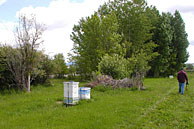- Number 291 |
- July 20, 2009
Bees, balloons, pollen to test novel CO2 monitoring approach

Joe Shaw, bee expert with Montana
State University, examines control
hives, distant from the carbon
dioxide injection area in this NETL
Bees and pollen are not just for honey anymore. Researchers at DOE's National Energy Technology Laboratory are using them—along with helium-filled balloons—in an innovative method to verify that no carbon dioxide (CO2) leaks from sequestration sites.
NETL-developed chemical tracers are co-injected at low levels to fingerprint the CO2, differentiating it from natural carbon dioxide. Researchers will determine if pollen collected by bees contains measurable quantities of tracer or if bees bring back tracer from direct contact with foliage. They will use balloons to determine atmospheric variations in tracer content to assess the effectiveness of CO2 storage sites.
NETL conducted the studies at the Center for Zero Emissions Research and Technology (ZERT) research site on an agricultural field at Montana State University (MSU) in Bozeman.
NETL researchers, in cooperation with bee experts at MSU, placed hives about 150 meters upwind and downwind from CO2 sources marked with tracers. A third control hive was located some distance from the test plot.
Along with the samples of the bees’ pollen, sorbent packets were placed near the hive entrances to monitor hive ventilation gas for tracer. A third monitor was placed about 25 meters from each hive in order to account for any background levels of tracer near the hive. Atmospheric tracer levels were also monitored throughout the test field using an extensive grid of monitors, and a light detection and ranging (LIDAR) system was employed by MSU researchers to correlate field tracer levels with bee foraging locations.
To determine atmospheric variations in tracer content to assess boundary-layer mixing processes, NETL researchers contracted Apogee Scientific to use a large helium-filled balloon to elevate a carousel containing sealed sorbent tubes above the field for sequential exposures of sorbent tubes at known times and known elevations. Researchers are conducting laboratory analysis of the tracer levels in the samples.
Submitted by DOE's National Energy Technology Laboratory
